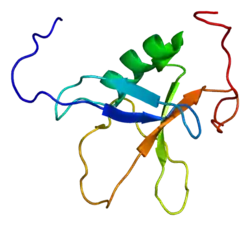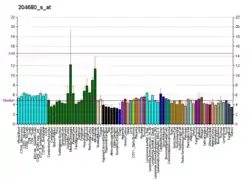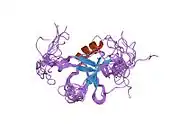RAPGEF5
Rap guanine nucleotide exchange factor 5 is a protein that in humans is encoded by the RAPGEF5 gene.[5][6][7]
Members of the RAS subfamily (see HRAS; MIM 190020) of GTPases function in signal transduction as GTP/GDP-regulated switches that cycle between inactive GDP- and active GTP-bound states. Guanine nucleotide exchange factors (GEFs), such as RAPGEF5, serve as RAS activators by promoting acquisition of GTP to maintain the active GTP-bound state and are the key link between cell surface receptors and RAS activation (Rebhun et al., 2000).[supplied by OMIM][7]
References
- GRCh38: Ensembl release 89: ENSG00000136237 - Ensembl, May 2017
- GRCm38: Ensembl release 89: ENSMUSG00000041992 - Ensembl, May 2017
- "Human PubMed Reference:". National Center for Biotechnology Information, U.S. National Library of Medicine.
- "Mouse PubMed Reference:". National Center for Biotechnology Information, U.S. National Library of Medicine.
- Nagase T, Seki N, Ishikawa K, Ohira M, Kawarabayasi Y, Ohara O, Tanaka A, Kotani H, Miyajima N, Nomura N (May 1997). "Prediction of the coding sequences of unidentified human genes. VI. The coding sequences of 80 new genes (KIAA0201-KIAA0280) deduced by analysis of cDNA clones from cell line KG-1 and brain". DNA Res. 3 (5): 321–9, 341–54. doi:10.1093/dnares/3.5.321. PMID 9039502.
- Ichiba T, Hoshi Y, Eto Y, Tajima N, Kuraishi Y (Oct 1999). "Characterization of GFR, a novel guanine nucleotide exchange factor for Rap1". FEBS Lett. 457 (1): 85–9. doi:10.1016/S0014-5793(99)01012-1. PMID 10486569. S2CID 20296877.
- "Entrez Gene: RAPGEF5 Rap guanine nucleotide exchange factor (GEF) 5".
Further reading
- de Rooij J, Rehmann H, van Triest M, et al. (2000). "Mechanism of regulation of the Epac family of cAMP-dependent RapGEFs". J. Biol. Chem. 275 (27): 20829–36. doi:10.1074/jbc.M001113200. PMID 10777494.
- Rebhun JF, Castro AF, Quilliam LA (2001). "Identification of guanine nucleotide exchange factors (GEFs) for the Rap1 GTPase. Regulation of MR-GEF by M-Ras-GTP interaction". J. Biol. Chem. 275 (45): 34901–8. doi:10.1074/jbc.M005327200. PMID 10934204.
- Strausberg RL, Feingold EA, Grouse LH, et al. (2003). "Generation and initial analysis of more than 15,000 full-length human and mouse cDNA sequences". Proc. Natl. Acad. Sci. U.S.A. 99 (26): 16899–903. doi:10.1073/pnas.242603899. PMC 139241. PMID 12477932.
- Scherer SW, Cheung J, MacDonald JR, et al. (2003). "Human chromosome 7: DNA sequence and biology". Science. 300 (5620): 767–72. doi:10.1126/science.1083423. PMC 2882961. PMID 12690205.
- Suzuki Y, Yamashita R, Shirota M, et al. (2004). "Sequence comparison of human and mouse genes reveals a homologous block structure in the promoter regions". Genome Res. 14 (9): 1711–8. doi:10.1101/gr.2435604. PMC 515316. PMID 15342556.
- Gerhard DS, Wagner L, Feingold EA, et al. (2004). "The status, quality, and expansion of the NIH full-length cDNA project: the Mammalian Gene Collection (MGC)". Genome Res. 14 (10B): 2121–7. doi:10.1101/gr.2596504. PMC 528928. PMID 15489334.
- Dupuy AG, L'Hoste S, Cherfils J, et al. (2005). "Novel Rap1 dominant-negative mutants interfere selectively with C3G and Epac". Oncogene. 24 (28): 4509–20. doi:10.1038/sj.onc.1208647. PMID 15856025.
This article is issued from Wikipedia. The text is licensed under Creative Commons - Attribution - Sharealike. Additional terms may apply for the media files.






